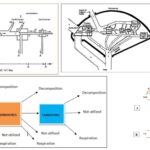IGCSE Biology 43 Views 1 Answers
Sourav PanLv 9November 14, 2024
Identify in diagrams and images the main organs of the digestive system, limited to: (a) alimentary canal: mouth, oesophagus, stomach, small intestine (duodenum and ileum) and large intestine (colon, rectum, anus) (b) associated organs: salivary glands, pancreas, liver and gall bladder
Identify in diagrams and images the main organs of the digestive system, limited to: (a) alimentary canal: mouth, oesophagus, stomach, small intestine (duodenum and ileum) and large intestine (colon, rectum, anus) (b) associated organs: salivary glands, pancreas, liver and gall bladder
Please login to save the post
Please login to submit an answer.
Sourav PanLv 9May 15, 2025
The main organs of the digestive system can be categorized into two groups: the alimentary canal and associated organs. Below is a description of each organ along with their functions.
(a) Alimentary Canal
- Mouth
- Function: The entry point for food where mechanical digestion begins through chewing, and chemical digestion starts with saliva from the salivary glands.
- Oesophagus
- Function: A muscular tube that transports food from the mouth to the stomach through peristaltic movements.
- Stomach
- Function: A hollow organ that stores food and mixes it with gastric juices to continue the digestion process, breaking down food into a semi-liquid form called chyme.
- Small Intestine
- Divisions:
- Duodenum: The first section where most chemical digestion occurs, receiving bile from the liver and digestive enzymes from the pancreas.
- Ileum: The final section where nutrient absorption occurs before passing undigested material to the large intestine.
- Divisions:
- Large Intestine
- Divisions:
- Colon: Absorbs water and electrolytes from indigestible food matter.
- Rectum: Stores feces until they are expelled.
- Anus: The opening at the end of the digestive tract through which feces are excreted.
- Divisions:
(b) Associated Organs
- Salivary Glands
- Function: Produce saliva that contains enzymes to begin the digestion of carbohydrates and lubricate food for easier swallowing.
- Pancreas
- Function: Produces digestive enzymes and bicarbonate, which are released into the small intestine to aid in digestion and neutralize stomach acid.
- Liver
- Function: Produces bile, which helps emulsify fats for digestion, and processes nutrients absorbed from the small intestine.
- Gall Bladder
- Function: Stores and concentrates bile produced by the liver until it is needed in the small intestine for fat digestion.
0
0 likes
- Share on Facebook
- Share on Twitter
- Share on LinkedIn
0 found this helpful out of 0 votes
Helpful: 0%
Helpful: 0%
Was this page helpful?




